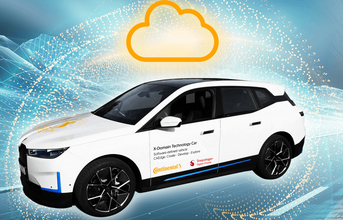
Continental has announced that it has implemented a cross-domain High-Performance Computer (HPC) in a car. For the first time, hosting cockpit and additional vehicle functions like driving safety and automated parking, including holistic motion control in a real-life vehicle application was made possible.
The SDV technology car utilises Continental's cloud-based Continental Automotive Edge Framework (CAEdge), which connects the vehicle to the cloud and features a virtual workbench to simplify and accelerate development, supply, and maintenance of software-intensive system functions. The implementation was leveraged by the Snapdragon Ride™ Flex System-on-Chip (SoC) with pre-integrated Snapdragon Ride Vision perception stack from Qualcomm Technologies, Inc.
"With the SDV technology car, we are able to demonstrate Continental's ecosystem: from road to cloud, from virtual to real," said Gilles Mabire, CTO at Continental Automotive. "As the first development partners for vehicle manufacturers in the world, we are proud of how we have moved beyond concepts and can showcase the capabilities and challenges of the convergence of automotive domains in a tangible software-defined vehicle."
Diverse portfolio of functions and development expertise
The SDV technology car demonstrates innovative solutions the Continental Automotive group sector portfolio has to offer in one vehicle architecture. The different technologies used include automated parking functions with holistic motion control, ultrasonic sensors, an integrated brake system, and surround view cameras - all within an innovative cross domain HPC.
"The goal is not only to show how well functions work, but to validate how well multiple technologies can be integrated and work alongside each other in HPC-based vehicle architectures within a software-defined vehicle," explained Jean-François Tarabbia, Head of Business Area Architecture and Networking at Continental Automotive. "This is a crucial step to convince the market that the goal to combine several control units in one HPC is not just feasible but can also render the cost benefits we want to achieve."
One key element for the implementation of the very first cross-domain HPC in a real car is the Snapdragon Ride Flex SoC, the automotive industry's first family of SoCs that supports multi-modal critical workloads on a single chip. The Flex SoC is designed for optimised cost, power, and performance. It makes it possible for automakers and suppliers to accelerate their time-to-market advantage and embrace a seamless, open, and adaptable approach to designing their vehicles.
"The concept of the software-defined vehicle relies heavily on high-performance hardware that can handle the amount of data," said Tarabbia. "With Qualcomm Technologies, we have the strong technical collaborator by our side, who shares our ambitious approach to bring the software-defined vehicle onto the road."
CAEdge provides cloud-based environment for efficient software development
The show car's software architecture has been developed using Continental's own cloud-based development platform for the software-defined vehicle. It connects the vehicle to the cloud and features a virtual workbench to simplify and accelerate development, supply, and maintenance of software-intensive system functions. This offers automotive software engineers the opportunity to test software on a virtual HPC before deploying onto the physical hardware and to fix software-related issues by debugging software directly in the cloud.



























